Leading and Managing Non-Profit Organizations: Stakeholder Perspective
VerifiedAdded on 2022/12/23
|10
|2346
|39
Annotated Bibliography
AI Summary
This annotated bibliography explores the application of stakeholder theory in leading and managing non-profit organizations. It critically analyzes various research articles discussing how stakeholder theory influences mission drift, collaboration between business and non-profit sectors, transparency in sustainability reports, effective governance, stakeholder communication, and resource allocation. The bibliography highlights the importance of stakeholder engagement in decision-making and resource management within non-profit organizations, emphasizing the benefits of a fairness approach in attracting and retaining stakeholders. The study concludes that stakeholder theory significantly contributes to the internal justification of pro-social values and the overall sustainability of non-profit operations. Desklib provides this document along with numerous other study resources for students.
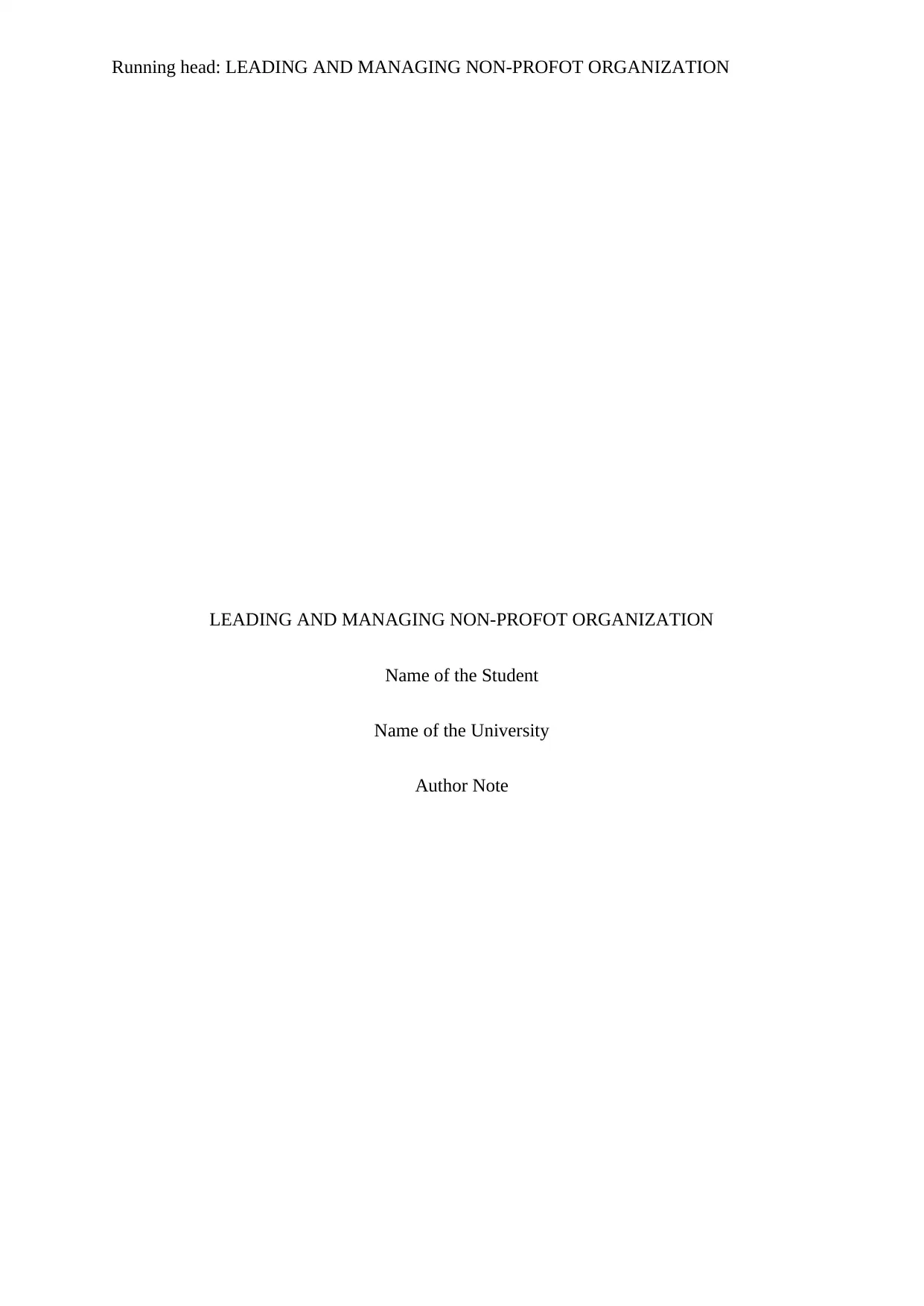
Running head: LEADING AND MANAGING NON-PROFOT ORGANIZATION
LEADING AND MANAGING NON-PROFOT ORGANIZATION
Name of the Student
Name of the University
Author Note
LEADING AND MANAGING NON-PROFOT ORGANIZATION
Name of the Student
Name of the University
Author Note
Paraphrase This Document
Need a fresh take? Get an instant paraphrase of this document with our AI Paraphraser
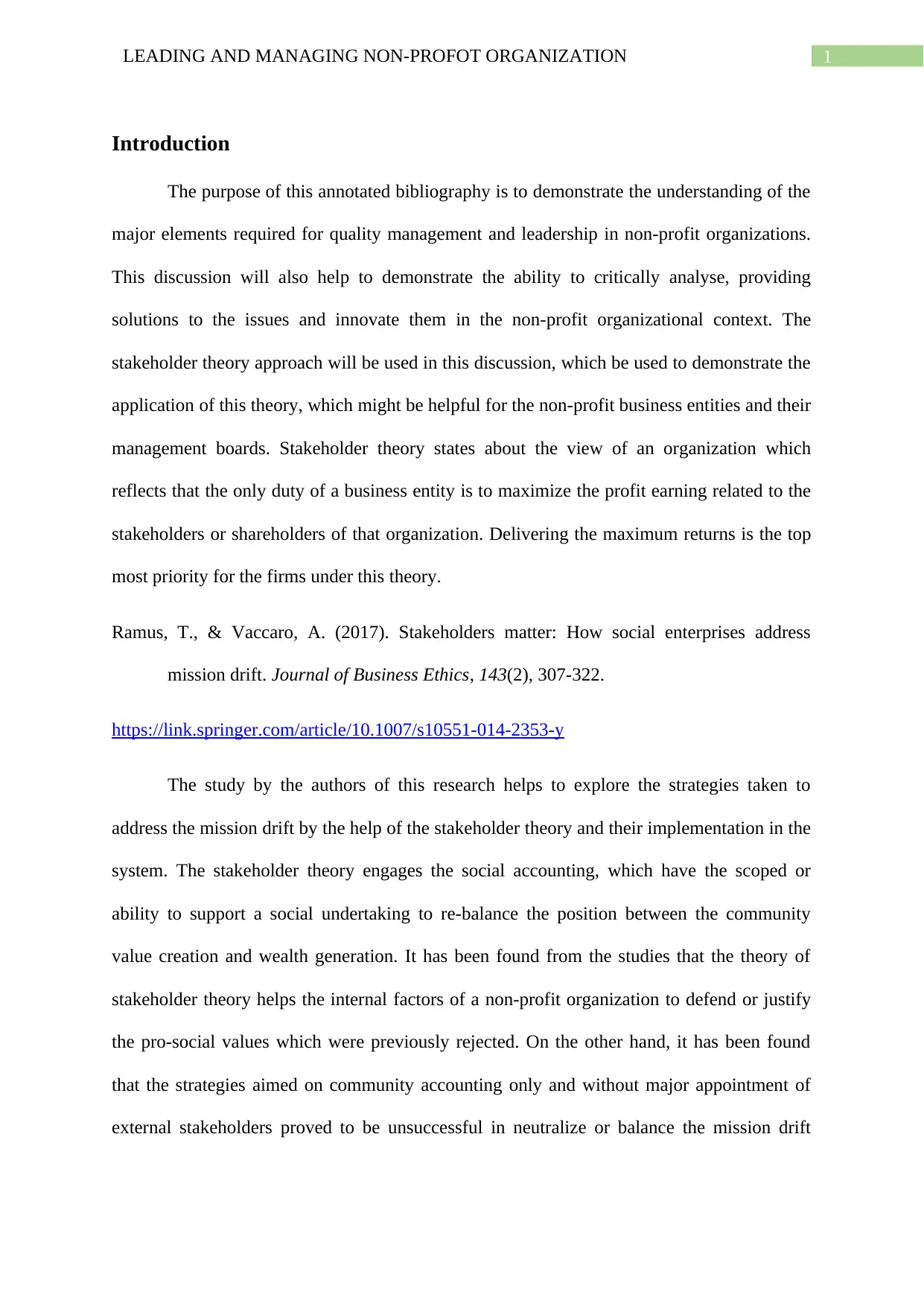
1LEADING AND MANAGING NON-PROFOT ORGANIZATION
Introduction
The purpose of this annotated bibliography is to demonstrate the understanding of the
major elements required for quality management and leadership in non-profit organizations.
This discussion will also help to demonstrate the ability to critically analyse, providing
solutions to the issues and innovate them in the non-profit organizational context. The
stakeholder theory approach will be used in this discussion, which be used to demonstrate the
application of this theory, which might be helpful for the non-profit business entities and their
management boards. Stakeholder theory states about the view of an organization which
reflects that the only duty of a business entity is to maximize the profit earning related to the
stakeholders or shareholders of that organization. Delivering the maximum returns is the top
most priority for the firms under this theory.
Ramus, T., & Vaccaro, A. (2017). Stakeholders matter: How social enterprises address
mission drift. Journal of Business Ethics, 143(2), 307-322.
https://link.springer.com/article/10.1007/s10551-014-2353-y
The study by the authors of this research helps to explore the strategies taken to
address the mission drift by the help of the stakeholder theory and their implementation in the
system. The stakeholder theory engages the social accounting, which have the scoped or
ability to support a social undertaking to re-balance the position between the community
value creation and wealth generation. It has been found from the studies that the theory of
stakeholder theory helps the internal factors of a non-profit organization to defend or justify
the pro-social values which were previously rejected. On the other hand, it has been found
that the strategies aimed on community accounting only and without major appointment of
external stakeholders proved to be unsuccessful in neutralize or balance the mission drift
Introduction
The purpose of this annotated bibliography is to demonstrate the understanding of the
major elements required for quality management and leadership in non-profit organizations.
This discussion will also help to demonstrate the ability to critically analyse, providing
solutions to the issues and innovate them in the non-profit organizational context. The
stakeholder theory approach will be used in this discussion, which be used to demonstrate the
application of this theory, which might be helpful for the non-profit business entities and their
management boards. Stakeholder theory states about the view of an organization which
reflects that the only duty of a business entity is to maximize the profit earning related to the
stakeholders or shareholders of that organization. Delivering the maximum returns is the top
most priority for the firms under this theory.
Ramus, T., & Vaccaro, A. (2017). Stakeholders matter: How social enterprises address
mission drift. Journal of Business Ethics, 143(2), 307-322.
https://link.springer.com/article/10.1007/s10551-014-2353-y
The study by the authors of this research helps to explore the strategies taken to
address the mission drift by the help of the stakeholder theory and their implementation in the
system. The stakeholder theory engages the social accounting, which have the scoped or
ability to support a social undertaking to re-balance the position between the community
value creation and wealth generation. It has been found from the studies that the theory of
stakeholder theory helps the internal factors of a non-profit organization to defend or justify
the pro-social values which were previously rejected. On the other hand, it has been found
that the strategies aimed on community accounting only and without major appointment of
external stakeholders proved to be unsuccessful in neutralize or balance the mission drift
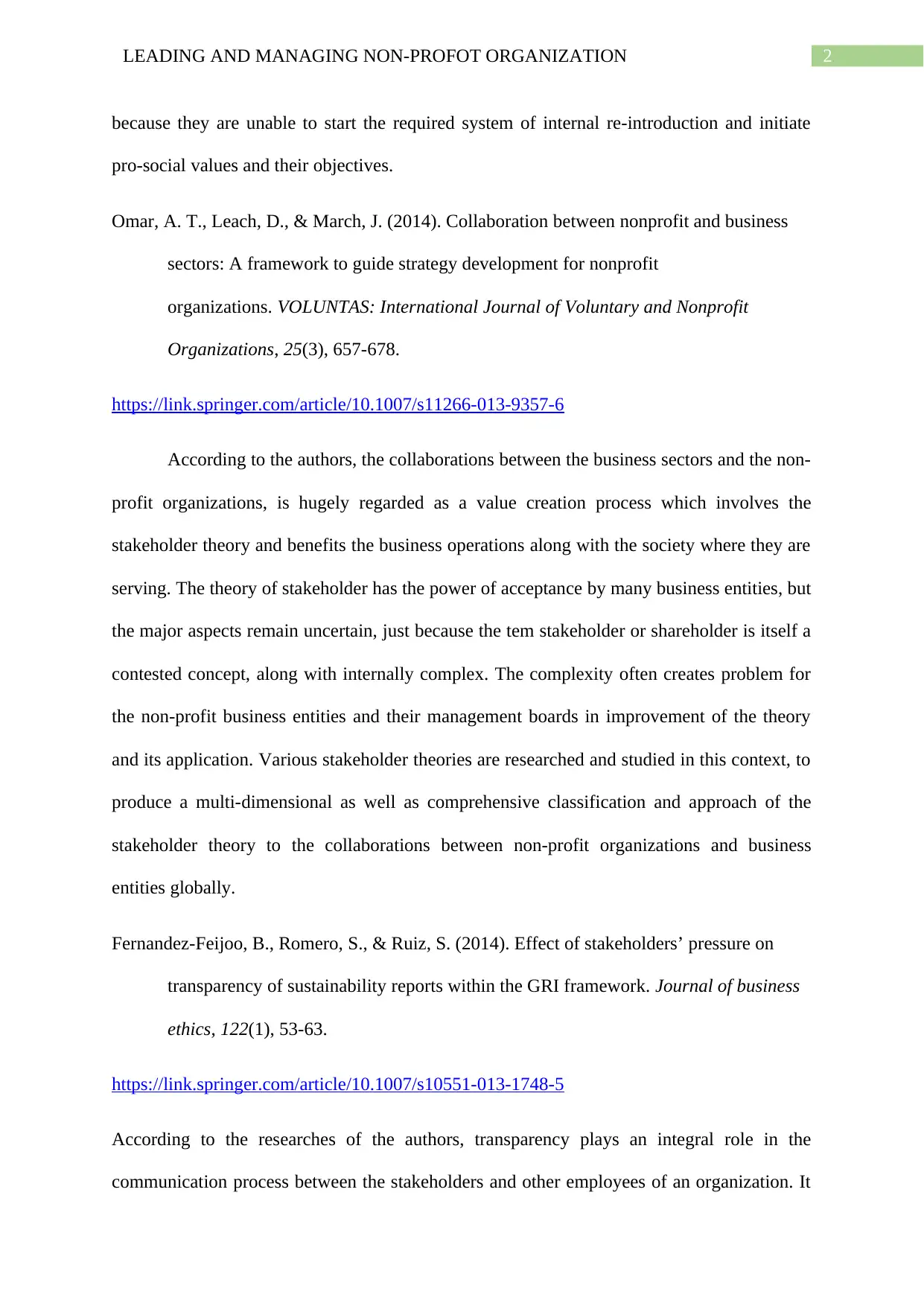
2LEADING AND MANAGING NON-PROFOT ORGANIZATION
because they are unable to start the required system of internal re-introduction and initiate
pro-social values and their objectives.
Omar, A. T., Leach, D., & March, J. (2014). Collaboration between nonprofit and business
sectors: A framework to guide strategy development for nonprofit
organizations. VOLUNTAS: International Journal of Voluntary and Nonprofit
Organizations, 25(3), 657-678.
https://link.springer.com/article/10.1007/s11266-013-9357-6
According to the authors, the collaborations between the business sectors and the non-
profit organizations, is hugely regarded as a value creation process which involves the
stakeholder theory and benefits the business operations along with the society where they are
serving. The theory of stakeholder has the power of acceptance by many business entities, but
the major aspects remain uncertain, just because the tem stakeholder or shareholder is itself a
contested concept, along with internally complex. The complexity often creates problem for
the non-profit business entities and their management boards in improvement of the theory
and its application. Various stakeholder theories are researched and studied in this context, to
produce a multi-dimensional as well as comprehensive classification and approach of the
stakeholder theory to the collaborations between non-profit organizations and business
entities globally.
Fernandez-Feijoo, B., Romero, S., & Ruiz, S. (2014). Effect of stakeholders’ pressure on
transparency of sustainability reports within the GRI framework. Journal of business
ethics, 122(1), 53-63.
https://link.springer.com/article/10.1007/s10551-013-1748-5
According to the researches of the authors, transparency plays an integral role in the
communication process between the stakeholders and other employees of an organization. It
because they are unable to start the required system of internal re-introduction and initiate
pro-social values and their objectives.
Omar, A. T., Leach, D., & March, J. (2014). Collaboration between nonprofit and business
sectors: A framework to guide strategy development for nonprofit
organizations. VOLUNTAS: International Journal of Voluntary and Nonprofit
Organizations, 25(3), 657-678.
https://link.springer.com/article/10.1007/s11266-013-9357-6
According to the authors, the collaborations between the business sectors and the non-
profit organizations, is hugely regarded as a value creation process which involves the
stakeholder theory and benefits the business operations along with the society where they are
serving. The theory of stakeholder has the power of acceptance by many business entities, but
the major aspects remain uncertain, just because the tem stakeholder or shareholder is itself a
contested concept, along with internally complex. The complexity often creates problem for
the non-profit business entities and their management boards in improvement of the theory
and its application. Various stakeholder theories are researched and studied in this context, to
produce a multi-dimensional as well as comprehensive classification and approach of the
stakeholder theory to the collaborations between non-profit organizations and business
entities globally.
Fernandez-Feijoo, B., Romero, S., & Ruiz, S. (2014). Effect of stakeholders’ pressure on
transparency of sustainability reports within the GRI framework. Journal of business
ethics, 122(1), 53-63.
https://link.springer.com/article/10.1007/s10551-013-1748-5
According to the researches of the authors, transparency plays an integral role in the
communication process between the stakeholders and other employees of an organization. It
⊘ This is a preview!⊘
Do you want full access?
Subscribe today to unlock all pages.

Trusted by 1+ million students worldwide
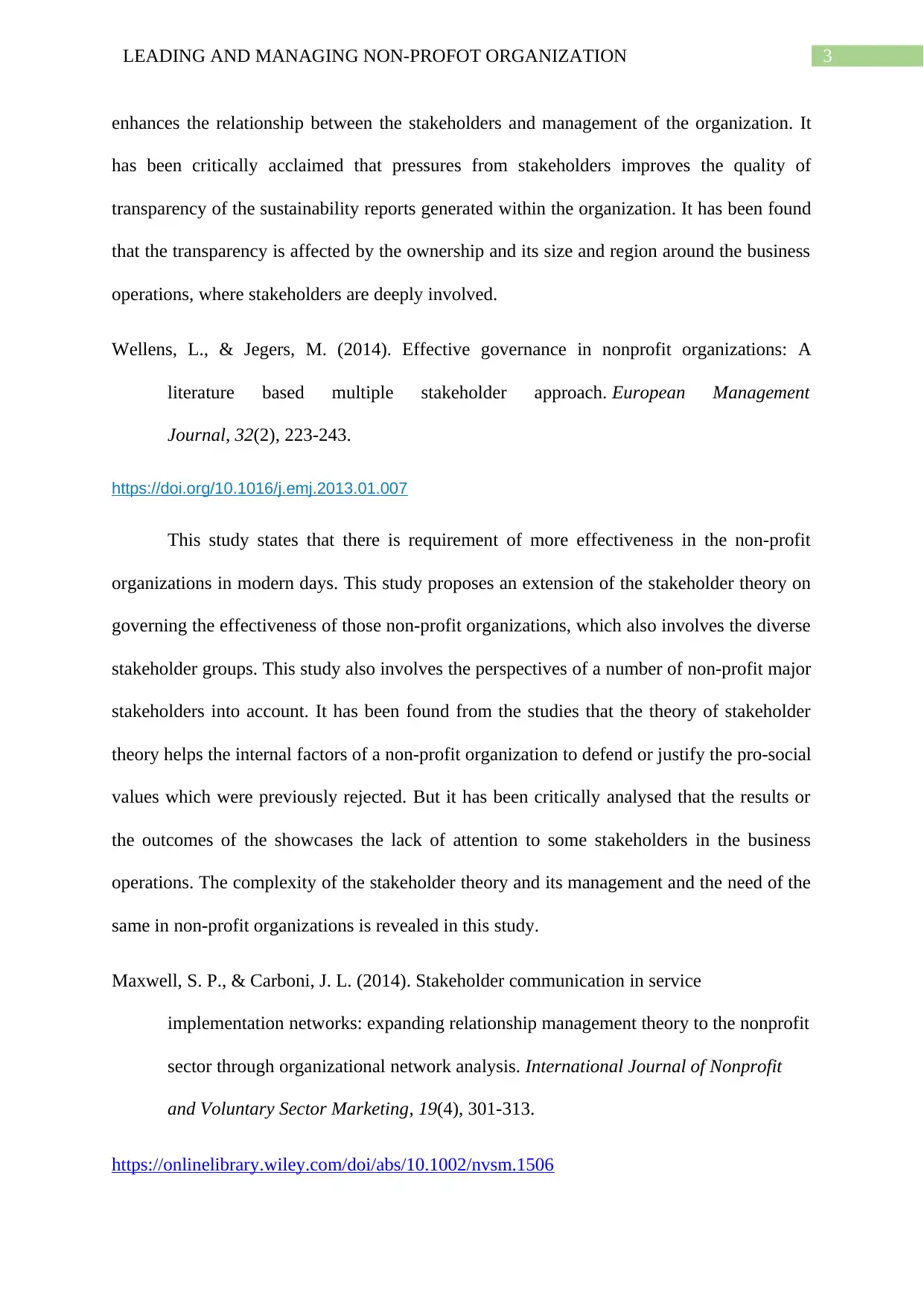
3LEADING AND MANAGING NON-PROFOT ORGANIZATION
enhances the relationship between the stakeholders and management of the organization. It
has been critically acclaimed that pressures from stakeholders improves the quality of
transparency of the sustainability reports generated within the organization. It has been found
that the transparency is affected by the ownership and its size and region around the business
operations, where stakeholders are deeply involved.
Wellens, L., & Jegers, M. (2014). Effective governance in nonprofit organizations: A
literature based multiple stakeholder approach. European Management
Journal, 32(2), 223-243.
https://doi.org/10.1016/j.emj.2013.01.007
This study states that there is requirement of more effectiveness in the non-profit
organizations in modern days. This study proposes an extension of the stakeholder theory on
governing the effectiveness of those non-profit organizations, which also involves the diverse
stakeholder groups. This study also involves the perspectives of a number of non-profit major
stakeholders into account. It has been found from the studies that the theory of stakeholder
theory helps the internal factors of a non-profit organization to defend or justify the pro-social
values which were previously rejected. But it has been critically analysed that the results or
the outcomes of the showcases the lack of attention to some stakeholders in the business
operations. The complexity of the stakeholder theory and its management and the need of the
same in non-profit organizations is revealed in this study.
Maxwell, S. P., & Carboni, J. L. (2014). Stakeholder communication in service
implementation networks: expanding relationship management theory to the nonprofit
sector through organizational network analysis. International Journal of Nonprofit
and Voluntary Sector Marketing, 19(4), 301-313.
https://onlinelibrary.wiley.com/doi/abs/10.1002/nvsm.1506
enhances the relationship between the stakeholders and management of the organization. It
has been critically acclaimed that pressures from stakeholders improves the quality of
transparency of the sustainability reports generated within the organization. It has been found
that the transparency is affected by the ownership and its size and region around the business
operations, where stakeholders are deeply involved.
Wellens, L., & Jegers, M. (2014). Effective governance in nonprofit organizations: A
literature based multiple stakeholder approach. European Management
Journal, 32(2), 223-243.
https://doi.org/10.1016/j.emj.2013.01.007
This study states that there is requirement of more effectiveness in the non-profit
organizations in modern days. This study proposes an extension of the stakeholder theory on
governing the effectiveness of those non-profit organizations, which also involves the diverse
stakeholder groups. This study also involves the perspectives of a number of non-profit major
stakeholders into account. It has been found from the studies that the theory of stakeholder
theory helps the internal factors of a non-profit organization to defend or justify the pro-social
values which were previously rejected. But it has been critically analysed that the results or
the outcomes of the showcases the lack of attention to some stakeholders in the business
operations. The complexity of the stakeholder theory and its management and the need of the
same in non-profit organizations is revealed in this study.
Maxwell, S. P., & Carboni, J. L. (2014). Stakeholder communication in service
implementation networks: expanding relationship management theory to the nonprofit
sector through organizational network analysis. International Journal of Nonprofit
and Voluntary Sector Marketing, 19(4), 301-313.
https://onlinelibrary.wiley.com/doi/abs/10.1002/nvsm.1506
Paraphrase This Document
Need a fresh take? Get an instant paraphrase of this document with our AI Paraphraser
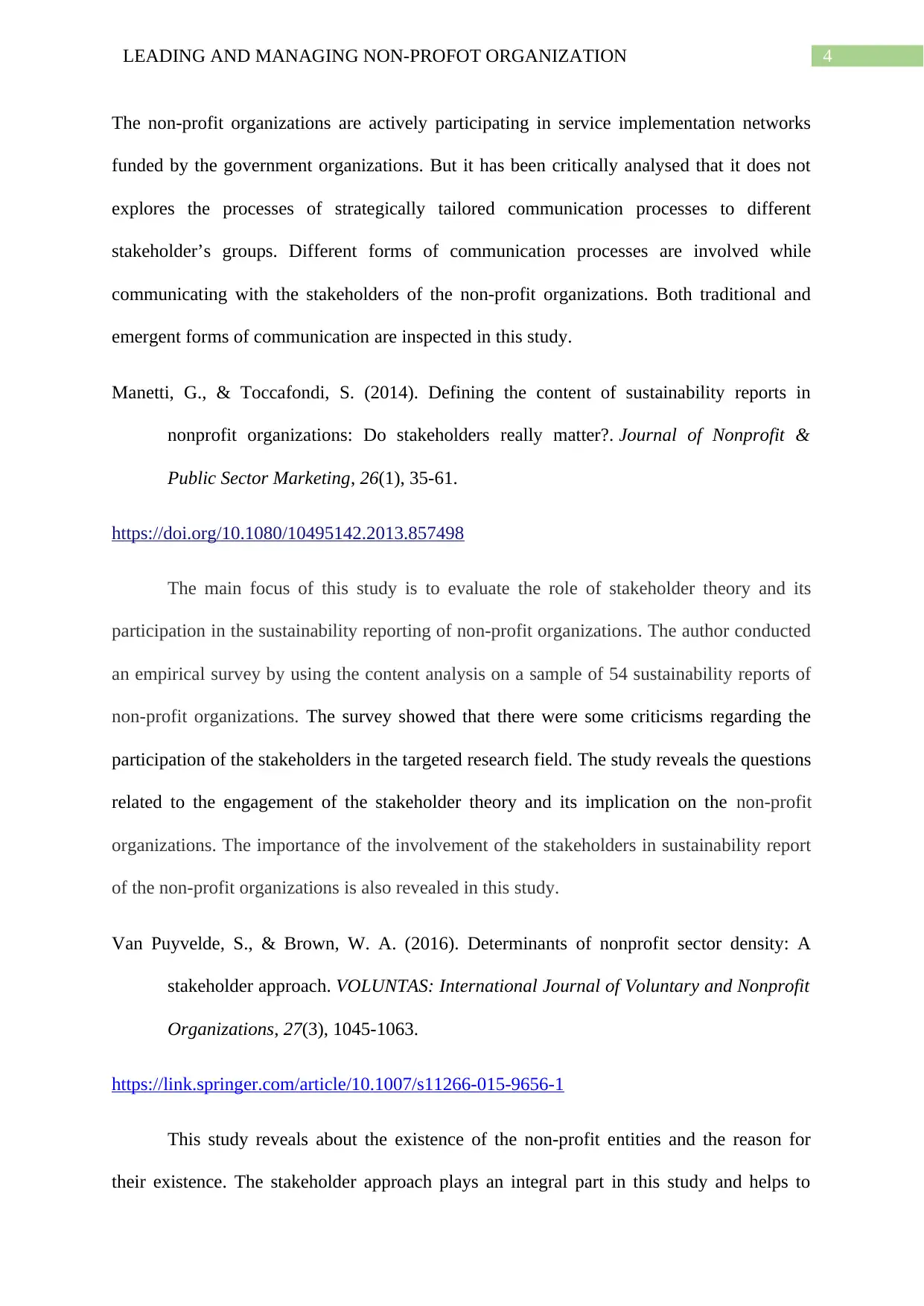
4LEADING AND MANAGING NON-PROFOT ORGANIZATION
The non-profit organizations are actively participating in service implementation networks
funded by the government organizations. But it has been critically analysed that it does not
explores the processes of strategically tailored communication processes to different
stakeholder’s groups. Different forms of communication processes are involved while
communicating with the stakeholders of the non-profit organizations. Both traditional and
emergent forms of communication are inspected in this study.
Manetti, G., & Toccafondi, S. (2014). Defining the content of sustainability reports in
nonprofit organizations: Do stakeholders really matter?. Journal of Nonprofit &
Public Sector Marketing, 26(1), 35-61.
https://doi.org/10.1080/10495142.2013.857498
The main focus of this study is to evaluate the role of stakeholder theory and its
participation in the sustainability reporting of non-profit organizations. The author conducted
an empirical survey by using the content analysis on a sample of 54 sustainability reports of
non-profit organizations. The survey showed that there were some criticisms regarding the
participation of the stakeholders in the targeted research field. The study reveals the questions
related to the engagement of the stakeholder theory and its implication on the non-profit
organizations. The importance of the involvement of the stakeholders in sustainability report
of the non-profit organizations is also revealed in this study.
Van Puyvelde, S., & Brown, W. A. (2016). Determinants of nonprofit sector density: A
stakeholder approach. VOLUNTAS: International Journal of Voluntary and Nonprofit
Organizations, 27(3), 1045-1063.
https://link.springer.com/article/10.1007/s11266-015-9656-1
This study reveals about the existence of the non-profit entities and the reason for
their existence. The stakeholder approach plays an integral part in this study and helps to
The non-profit organizations are actively participating in service implementation networks
funded by the government organizations. But it has been critically analysed that it does not
explores the processes of strategically tailored communication processes to different
stakeholder’s groups. Different forms of communication processes are involved while
communicating with the stakeholders of the non-profit organizations. Both traditional and
emergent forms of communication are inspected in this study.
Manetti, G., & Toccafondi, S. (2014). Defining the content of sustainability reports in
nonprofit organizations: Do stakeholders really matter?. Journal of Nonprofit &
Public Sector Marketing, 26(1), 35-61.
https://doi.org/10.1080/10495142.2013.857498
The main focus of this study is to evaluate the role of stakeholder theory and its
participation in the sustainability reporting of non-profit organizations. The author conducted
an empirical survey by using the content analysis on a sample of 54 sustainability reports of
non-profit organizations. The survey showed that there were some criticisms regarding the
participation of the stakeholders in the targeted research field. The study reveals the questions
related to the engagement of the stakeholder theory and its implication on the non-profit
organizations. The importance of the involvement of the stakeholders in sustainability report
of the non-profit organizations is also revealed in this study.
Van Puyvelde, S., & Brown, W. A. (2016). Determinants of nonprofit sector density: A
stakeholder approach. VOLUNTAS: International Journal of Voluntary and Nonprofit
Organizations, 27(3), 1045-1063.
https://link.springer.com/article/10.1007/s11266-015-9656-1
This study reveals about the existence of the non-profit entities and the reason for
their existence. The stakeholder approach plays an integral part in this study and helps to
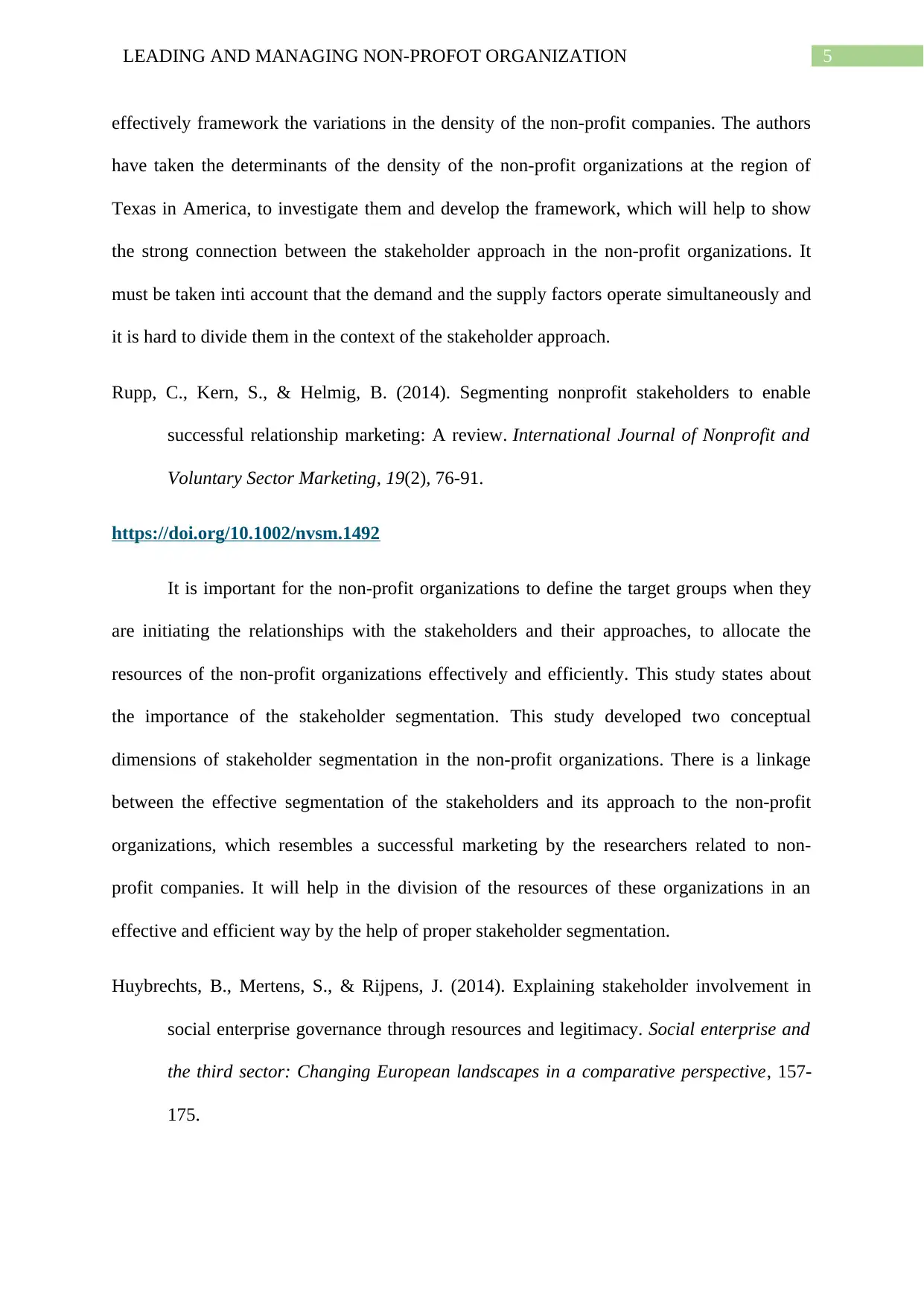
5LEADING AND MANAGING NON-PROFOT ORGANIZATION
effectively framework the variations in the density of the non-profit companies. The authors
have taken the determinants of the density of the non-profit organizations at the region of
Texas in America, to investigate them and develop the framework, which will help to show
the strong connection between the stakeholder approach in the non-profit organizations. It
must be taken inti account that the demand and the supply factors operate simultaneously and
it is hard to divide them in the context of the stakeholder approach.
Rupp, C., Kern, S., & Helmig, B. (2014). Segmenting nonprofit stakeholders to enable
successful relationship marketing: A review. International Journal of Nonprofit and
Voluntary Sector Marketing, 19(2), 76-91.
https://doi.org/10.1002/nvsm.1492
It is important for the non-profit organizations to define the target groups when they
are initiating the relationships with the stakeholders and their approaches, to allocate the
resources of the non-profit organizations effectively and efficiently. This study states about
the importance of the stakeholder segmentation. This study developed two conceptual
dimensions of stakeholder segmentation in the non-profit organizations. There is a linkage
between the effective segmentation of the stakeholders and its approach to the non-profit
organizations, which resembles a successful marketing by the researchers related to non-
profit companies. It will help in the division of the resources of these organizations in an
effective and efficient way by the help of proper stakeholder segmentation.
Huybrechts, B., Mertens, S., & Rijpens, J. (2014). Explaining stakeholder involvement in
social enterprise governance through resources and legitimacy. Social enterprise and
the third sector: Changing European landscapes in a comparative perspective, 157-
175.
effectively framework the variations in the density of the non-profit companies. The authors
have taken the determinants of the density of the non-profit organizations at the region of
Texas in America, to investigate them and develop the framework, which will help to show
the strong connection between the stakeholder approach in the non-profit organizations. It
must be taken inti account that the demand and the supply factors operate simultaneously and
it is hard to divide them in the context of the stakeholder approach.
Rupp, C., Kern, S., & Helmig, B. (2014). Segmenting nonprofit stakeholders to enable
successful relationship marketing: A review. International Journal of Nonprofit and
Voluntary Sector Marketing, 19(2), 76-91.
https://doi.org/10.1002/nvsm.1492
It is important for the non-profit organizations to define the target groups when they
are initiating the relationships with the stakeholders and their approaches, to allocate the
resources of the non-profit organizations effectively and efficiently. This study states about
the importance of the stakeholder segmentation. This study developed two conceptual
dimensions of stakeholder segmentation in the non-profit organizations. There is a linkage
between the effective segmentation of the stakeholders and its approach to the non-profit
organizations, which resembles a successful marketing by the researchers related to non-
profit companies. It will help in the division of the resources of these organizations in an
effective and efficient way by the help of proper stakeholder segmentation.
Huybrechts, B., Mertens, S., & Rijpens, J. (2014). Explaining stakeholder involvement in
social enterprise governance through resources and legitimacy. Social enterprise and
the third sector: Changing European landscapes in a comparative perspective, 157-
175.
⊘ This is a preview!⊘
Do you want full access?
Subscribe today to unlock all pages.

Trusted by 1+ million students worldwide
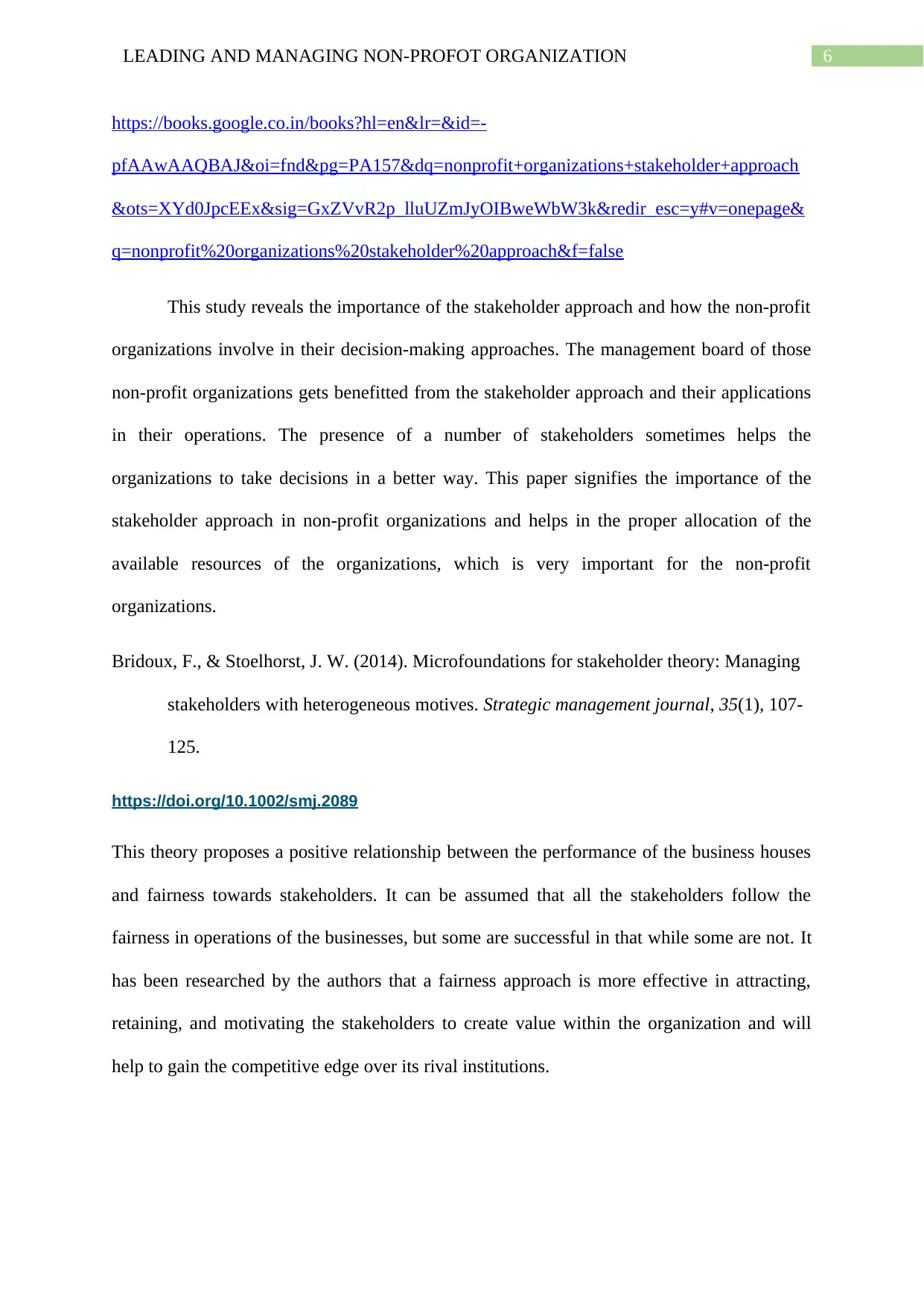
6LEADING AND MANAGING NON-PROFOT ORGANIZATION
https://books.google.co.in/books?hl=en&lr=&id=-
pfAAwAAQBAJ&oi=fnd&pg=PA157&dq=nonprofit+organizations+stakeholder+approach
&ots=XYd0JpcEEx&sig=GxZVvR2p_lluUZmJyOIBweWbW3k&redir_esc=y#v=onepage&
q=nonprofit%20organizations%20stakeholder%20approach&f=false
This study reveals the importance of the stakeholder approach and how the non-profit
organizations involve in their decision-making approaches. The management board of those
non-profit organizations gets benefitted from the stakeholder approach and their applications
in their operations. The presence of a number of stakeholders sometimes helps the
organizations to take decisions in a better way. This paper signifies the importance of the
stakeholder approach in non-profit organizations and helps in the proper allocation of the
available resources of the organizations, which is very important for the non-profit
organizations.
Bridoux, F., & Stoelhorst, J. W. (2014). Microfoundations for stakeholder theory: Managing
stakeholders with heterogeneous motives. Strategic management journal, 35(1), 107-
125.
https://doi.org/10.1002/smj.2089
This theory proposes a positive relationship between the performance of the business houses
and fairness towards stakeholders. It can be assumed that all the stakeholders follow the
fairness in operations of the businesses, but some are successful in that while some are not. It
has been researched by the authors that a fairness approach is more effective in attracting,
retaining, and motivating the stakeholders to create value within the organization and will
help to gain the competitive edge over its rival institutions.
https://books.google.co.in/books?hl=en&lr=&id=-
pfAAwAAQBAJ&oi=fnd&pg=PA157&dq=nonprofit+organizations+stakeholder+approach
&ots=XYd0JpcEEx&sig=GxZVvR2p_lluUZmJyOIBweWbW3k&redir_esc=y#v=onepage&
q=nonprofit%20organizations%20stakeholder%20approach&f=false
This study reveals the importance of the stakeholder approach and how the non-profit
organizations involve in their decision-making approaches. The management board of those
non-profit organizations gets benefitted from the stakeholder approach and their applications
in their operations. The presence of a number of stakeholders sometimes helps the
organizations to take decisions in a better way. This paper signifies the importance of the
stakeholder approach in non-profit organizations and helps in the proper allocation of the
available resources of the organizations, which is very important for the non-profit
organizations.
Bridoux, F., & Stoelhorst, J. W. (2014). Microfoundations for stakeholder theory: Managing
stakeholders with heterogeneous motives. Strategic management journal, 35(1), 107-
125.
https://doi.org/10.1002/smj.2089
This theory proposes a positive relationship between the performance of the business houses
and fairness towards stakeholders. It can be assumed that all the stakeholders follow the
fairness in operations of the businesses, but some are successful in that while some are not. It
has been researched by the authors that a fairness approach is more effective in attracting,
retaining, and motivating the stakeholders to create value within the organization and will
help to gain the competitive edge over its rival institutions.
Paraphrase This Document
Need a fresh take? Get an instant paraphrase of this document with our AI Paraphraser
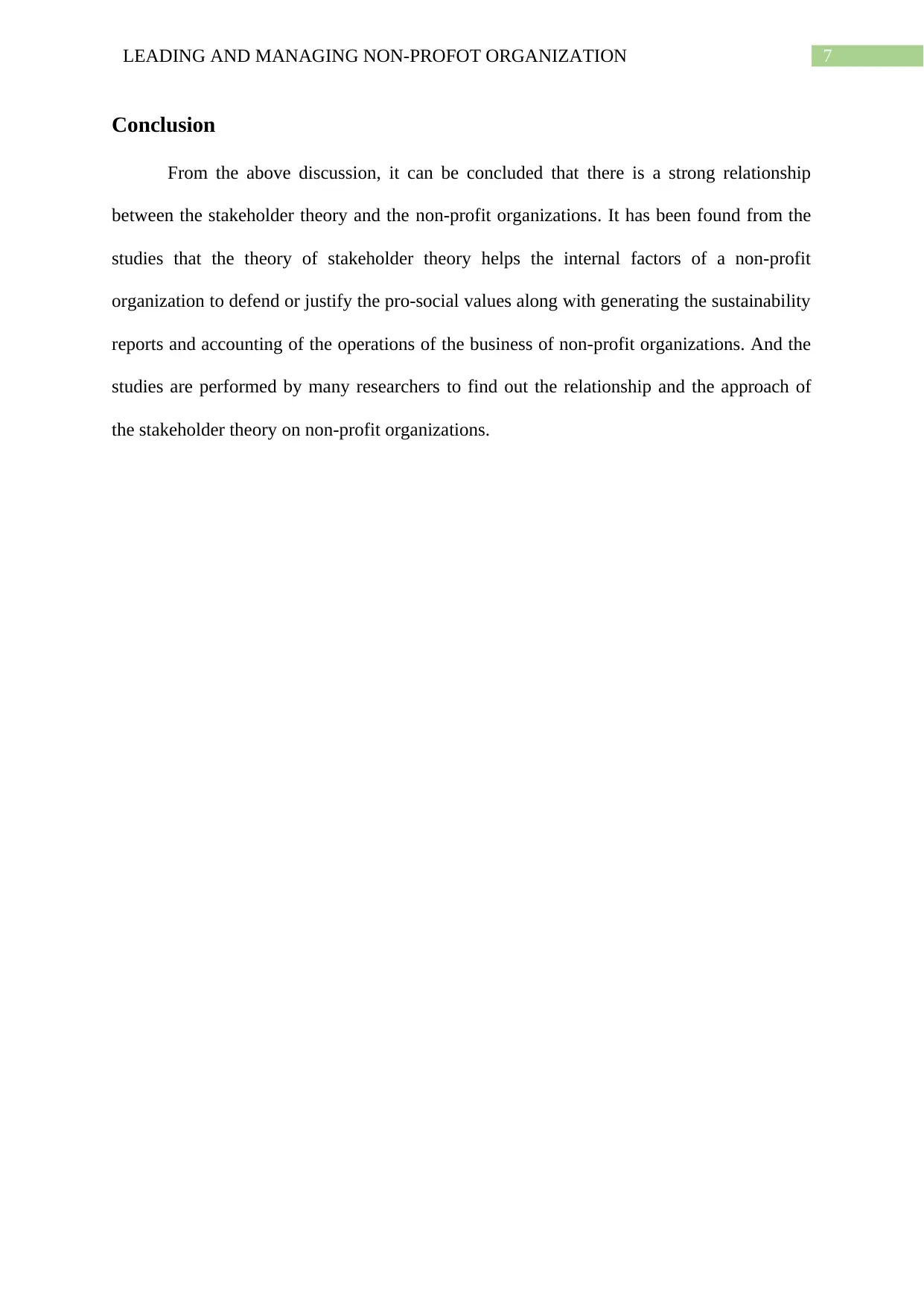
7LEADING AND MANAGING NON-PROFOT ORGANIZATION
Conclusion
From the above discussion, it can be concluded that there is a strong relationship
between the stakeholder theory and the non-profit organizations. It has been found from the
studies that the theory of stakeholder theory helps the internal factors of a non-profit
organization to defend or justify the pro-social values along with generating the sustainability
reports and accounting of the operations of the business of non-profit organizations. And the
studies are performed by many researchers to find out the relationship and the approach of
the stakeholder theory on non-profit organizations.
Conclusion
From the above discussion, it can be concluded that there is a strong relationship
between the stakeholder theory and the non-profit organizations. It has been found from the
studies that the theory of stakeholder theory helps the internal factors of a non-profit
organization to defend or justify the pro-social values along with generating the sustainability
reports and accounting of the operations of the business of non-profit organizations. And the
studies are performed by many researchers to find out the relationship and the approach of
the stakeholder theory on non-profit organizations.
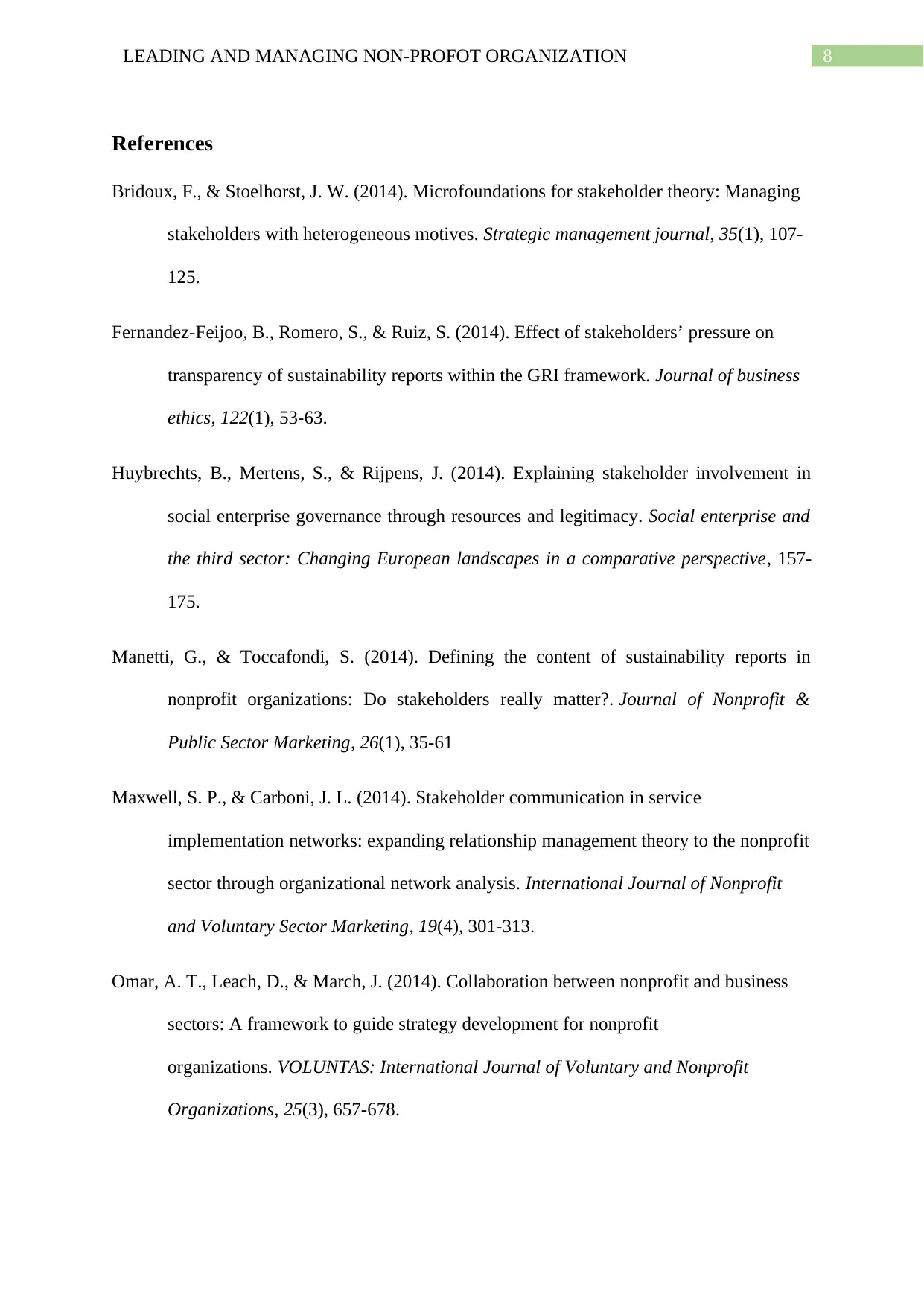
8LEADING AND MANAGING NON-PROFOT ORGANIZATION
References
Bridoux, F., & Stoelhorst, J. W. (2014). Microfoundations for stakeholder theory: Managing
stakeholders with heterogeneous motives. Strategic management journal, 35(1), 107-
125.
Fernandez-Feijoo, B., Romero, S., & Ruiz, S. (2014). Effect of stakeholders’ pressure on
transparency of sustainability reports within the GRI framework. Journal of business
ethics, 122(1), 53-63.
Huybrechts, B., Mertens, S., & Rijpens, J. (2014). Explaining stakeholder involvement in
social enterprise governance through resources and legitimacy. Social enterprise and
the third sector: Changing European landscapes in a comparative perspective, 157-
175.
Manetti, G., & Toccafondi, S. (2014). Defining the content of sustainability reports in
nonprofit organizations: Do stakeholders really matter?. Journal of Nonprofit &
Public Sector Marketing, 26(1), 35-61
Maxwell, S. P., & Carboni, J. L. (2014). Stakeholder communication in service
implementation networks: expanding relationship management theory to the nonprofit
sector through organizational network analysis. International Journal of Nonprofit
and Voluntary Sector Marketing, 19(4), 301-313.
Omar, A. T., Leach, D., & March, J. (2014). Collaboration between nonprofit and business
sectors: A framework to guide strategy development for nonprofit
organizations. VOLUNTAS: International Journal of Voluntary and Nonprofit
Organizations, 25(3), 657-678.
References
Bridoux, F., & Stoelhorst, J. W. (2014). Microfoundations for stakeholder theory: Managing
stakeholders with heterogeneous motives. Strategic management journal, 35(1), 107-
125.
Fernandez-Feijoo, B., Romero, S., & Ruiz, S. (2014). Effect of stakeholders’ pressure on
transparency of sustainability reports within the GRI framework. Journal of business
ethics, 122(1), 53-63.
Huybrechts, B., Mertens, S., & Rijpens, J. (2014). Explaining stakeholder involvement in
social enterprise governance through resources and legitimacy. Social enterprise and
the third sector: Changing European landscapes in a comparative perspective, 157-
175.
Manetti, G., & Toccafondi, S. (2014). Defining the content of sustainability reports in
nonprofit organizations: Do stakeholders really matter?. Journal of Nonprofit &
Public Sector Marketing, 26(1), 35-61
Maxwell, S. P., & Carboni, J. L. (2014). Stakeholder communication in service
implementation networks: expanding relationship management theory to the nonprofit
sector through organizational network analysis. International Journal of Nonprofit
and Voluntary Sector Marketing, 19(4), 301-313.
Omar, A. T., Leach, D., & March, J. (2014). Collaboration between nonprofit and business
sectors: A framework to guide strategy development for nonprofit
organizations. VOLUNTAS: International Journal of Voluntary and Nonprofit
Organizations, 25(3), 657-678.
⊘ This is a preview!⊘
Do you want full access?
Subscribe today to unlock all pages.

Trusted by 1+ million students worldwide
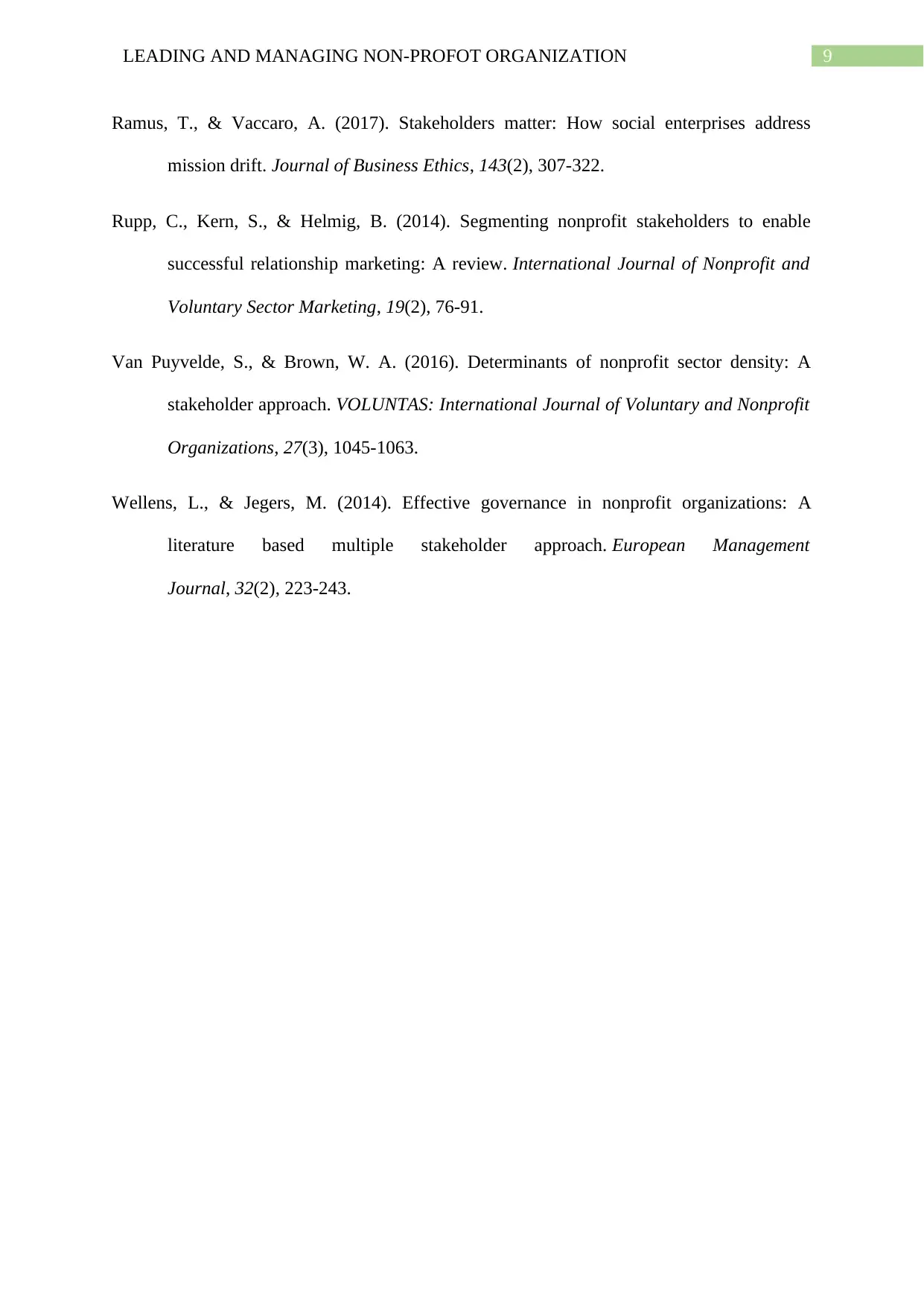
9LEADING AND MANAGING NON-PROFOT ORGANIZATION
Ramus, T., & Vaccaro, A. (2017). Stakeholders matter: How social enterprises address
mission drift. Journal of Business Ethics, 143(2), 307-322.
Rupp, C., Kern, S., & Helmig, B. (2014). Segmenting nonprofit stakeholders to enable
successful relationship marketing: A review. International Journal of Nonprofit and
Voluntary Sector Marketing, 19(2), 76-91.
Van Puyvelde, S., & Brown, W. A. (2016). Determinants of nonprofit sector density: A
stakeholder approach. VOLUNTAS: International Journal of Voluntary and Nonprofit
Organizations, 27(3), 1045-1063.
Wellens, L., & Jegers, M. (2014). Effective governance in nonprofit organizations: A
literature based multiple stakeholder approach. European Management
Journal, 32(2), 223-243.
Ramus, T., & Vaccaro, A. (2017). Stakeholders matter: How social enterprises address
mission drift. Journal of Business Ethics, 143(2), 307-322.
Rupp, C., Kern, S., & Helmig, B. (2014). Segmenting nonprofit stakeholders to enable
successful relationship marketing: A review. International Journal of Nonprofit and
Voluntary Sector Marketing, 19(2), 76-91.
Van Puyvelde, S., & Brown, W. A. (2016). Determinants of nonprofit sector density: A
stakeholder approach. VOLUNTAS: International Journal of Voluntary and Nonprofit
Organizations, 27(3), 1045-1063.
Wellens, L., & Jegers, M. (2014). Effective governance in nonprofit organizations: A
literature based multiple stakeholder approach. European Management
Journal, 32(2), 223-243.
1 out of 10
Related Documents
Your All-in-One AI-Powered Toolkit for Academic Success.
+13062052269
info@desklib.com
Available 24*7 on WhatsApp / Email
![[object Object]](/_next/static/media/star-bottom.7253800d.svg)
Unlock your academic potential
Copyright © 2020–2025 A2Z Services. All Rights Reserved. Developed and managed by ZUCOL.





